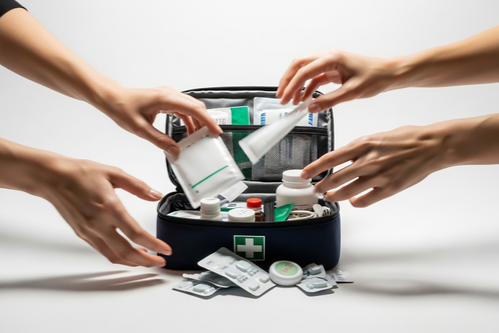
The set of medicines and materials for household emergencies can be kept in a box, bag, case or a clean drawer. It should be sturdy and have enough space to ensure that the items are organized and protected. It should be identified on the outside with a visible label.
It should not have a lock or be protected by codes or passwords, as this could delay access to the material in emergency situations.
Its content should be adapted to the needs of the members of the household. In the case of medicines, it may have to include different dosages and pharmaceutical forms (tablets and syrups, for example) suited to the ages of the various family members.
Its location should be known to family members. The place chosen should be cool and dry, easily accessible, separate from food or cleaning products and out of the reach of children. The kitchen and bathroom are not the most suitable places, as they undergo sudden changes in temperature and humidity which can damage the medicines.
The first aid kit should include medicines for minor conditions and symptoms, an easy-to-read thermometer in good working order and material for bandages. A first aid manual may also be useful, as well as emergency contact details for your health center or family doctor. It should also be visibly displayed if any family members are allergic to any medication.
IMPORTANT EMERGENCY CONTACTS:
The set of medicines and materials for household emergencies should be kept in its own place and should not contain the daily medicines used by family members. These should be stored elsewhere to avoid confusion.
Avoid keeping large quantities of medicines. As well as making it difficult to organize and store them properly, this can lead to waste.
Do not include medicines without their original packaging or information leaflet, out of date, in poor condition, or from incomplete previous treatments. Medicines prescribed by a doctor for a specific illness should not be included in the first aid kit. This is particularly important in the case of antibiotics, which should only be used on prescription for a particular person and for a specific infection, and should not be kept "just in case".
It is also not advisable to keep eye drops, with the exception of single-dose presentations, as they have a short shelf life once opened (always consult the package leaflet). Nasal drops should also be avoided due to the high risk of contamination.
Ensure that the material is in good condition by replacing damaged or oxidized tweezers, scissors or other utensils.
In addition, any product that shows changes in color, smell or texture should be discarded, even if it is within its expiration date.
Pharmacies have a specific container for collecting medicines that have deteriorated or expired. Ask your pharmacist for the VALORMED container.
Keeping your first aid kit well organized, up-to-date and accessible is a simple measure that can have a big impact on your family's safety and well-being. If in doubt about the most suitable products, consult your pharmacist.
copyright © Ordem dos Farmacêuticos
________
WITH SHEE'S HELP
Find a multidisciplinary team of health professionals, always with friendly advice, to provide you with safe, close and personalized care.
Register now 👉 here.
Make an appointment with your pharmacist 👉 here.
Discover all the products, at the best prices, all year round, in the online store 🛒.
Life is easier when you're healthy.